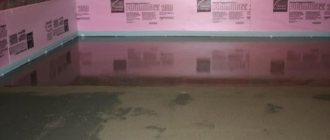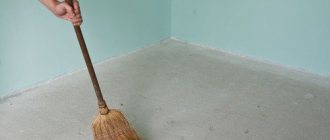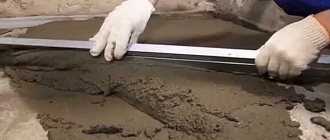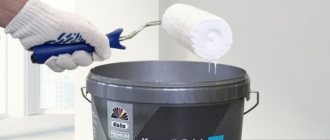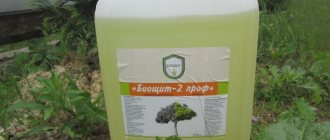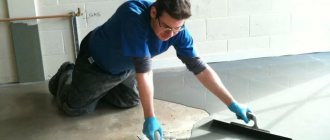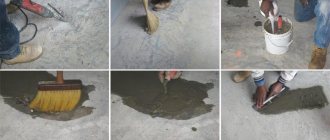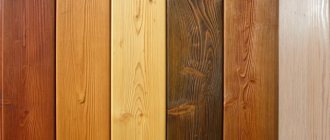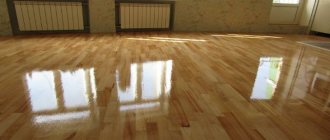To install a reliable floor, you need a strong, as level base as possible. It is for these purposes that a floor leveling mixture is used, which allows you to create an ideal surface for any modern covering. Such mixtures have many advantages compared to classic screeds, so they are increasingly used not only by professional builders, but also by home craftsmen.
Floor leveling mixture
What is a floor leveler?
Of course, it is possible to make a screed using a regular mortar, for which a mixture of cement, sand, as well as gravel or crushed stone is prepared in advance.
But if you use a leveler, the process of leveling the floors will become much faster. The benefit of all levelers is that they represent a certain prepared mixture in equal proportions. Such formulations are developed strictly taking into account the selection of all necessary ingredients.
It is also important to take care of the optimal level of water in the solution during the creation of the cement composition.
Of course, today there are quite a few levelers on the market from different manufacturers. Therefore, there is always a choice.
Peculiarities
Floor screed in new houses does not always have a smooth surface. But it is very important for high-quality flooring, as well as the appearance of any room. There is no point in doing even decorative finishing on such a surface. All defects, such as depressions and bumps, will be noticeable later on the final coating.
Characteristics of leveling mixtures
If previously the composition of the mortar for screeding was prepared directly on the site, now dry mixtures are used to level the floor, to which it is enough to add a certain amount of water. They contain all the necessary components to obtain high-quality results. In addition, the proportions are fully respected in relation to each other.
Leveling mixtures for floors are quick-hardening compounds with plasticity and excellent fluidity. They are usually presented in the form of dry mixtures or concentrates, which contain appropriate additives. All that remains is to add the required amount of water and pour it over the entire area of the room. Any unevenness in the subfloor will be hidden, and the surface will become perfectly smooth.
Purpose of floor leveler
Regarding their purpose, all leveling mixtures can be divided into:
- Levelers for deep correction of unevenness. Such mixtures allow you to pour screeds 70x80 m thick at a time. In the production of all coarse levelers, coarse cement components are used, but the filler in this case is always sand;
- Levelers for leveling shallow surfaces. Such substances always contain gypsum and cement. All substances are very finely resinous. They can be used for screeds with a thickness of 2-3 mm;
- Here you can create a third group of levelers. Among them are mixtures whose purpose is to level both “thick” surfaces and thin surfaces. The instructions for their use indicate the ranges of their use.
There are also levelers, the components of which include polymer components. They ensure the fluidity of the entire composition. Levelers are characterized by high adhesive properties.
According to physical equations, after pouring the floors, the mixture is automatically spread horizontally. Such levelers are often called self-layering.
Right choice
A good floor leveling mixture should be selected taking into account the customer's requirements. The selection is made for a particular room and taking into account humidity and temperature indicators. The drying time of the finished solution can also play a decisive role. This factor is especially necessary when repairs in a room are under tight deadlines.
Despite the self-leveling floor, the thick layer even helps to provide a high quality and reliable surface. Such floors are very easy to use, as they do not require excessive attention. After complete drying, they do not have any effect on human health. This must be avoided only during the drying process, when a large amount of harmful substances is released.
Floor leveling compound is very easy to prepare. The installation of the base is carried out in the same way. It is enough to follow the recommendations from the manufacturer. Consultation with specialists will allow you to make the final choice in favor of a specific type of self-leveling mixture. They will know everything about it, since they have to deal with them all the time.
Under no circumstances should water be poured into the dry mixture for leveling the floor in larger quantities in order to obtain the volume of the solution. This will immediately reduce all performance characteristics and qualities when drying. Following the instructions exactly will help you get a truly high-quality result.
If you do not have minimal knowledge in this area of the construction industry, then it is better to entrust the work to professionals. By paying for their service, you won’t have to waste your own time and worry about the outcome. It will be cheaper to do just this than to subsequently spend enormous effort and money on dismantling the self-leveling floor due to a violation of the device’s technology.
How to choose the right leveling mixture
To choose a high-quality floor covering, you need to check the composition of the composites. Thus, you should always review the purpose of the mixture. The intended purpose is always indicated on the packaging. You can also find the ingredients on the package.
It is especially important to consider the range of permissible floor filling. You always need to know the size of the tie. It is also important to know how much liquid is needed to make the floor perfectly level.
Some levelers may contain gypsum. Gypsum affects how long the composition will last. Those. within the specified period, it is necessary to correctly distribute the leveler over the surface, as well as provide it with conditions for comfortable distribution over all surfaces.
If you neglect these indicators, the coating may turn out uneven.
- For many, frost resistance is important. This indicator is denoted by the Latin letter F, as well as a number.
- It indicates how many freezing cycles the coating is guaranteed to withstand. The norm is considered to be no lower than F50.
- The packaging also indicates the drying time of the floor covering. It is determined by several numbers.
- The first number indicates the period of spreading of the mixture over the surface. For most mixtures this period varies from 4 to 6 hours.
- The second number indicates the maturation period of the mixture, i.e. period of complete drying.
It must be said that no matter what the mixture is, raw lumps can always form in the dry ingredients. Such lumps can seriously damage the ergonomics of the coating. They can even cause future cracks. Therefore, you should always ensure that the goods are not expired.
Regarding the choice of brand, it is very difficult to say. You should always pay attention to the performance of components. Of course, preference is always given to proven mixtures. These include “Bergauf”, “Vetonit”, “Plitonit”, “UNIS” and others. The choice of floor levelers varies across geographic regions.
When choosing a brand, you need to be wary of fakes. Some people deliberately hide cheap or damaged goods under the label of a well-known brand. It is necessary not only to look at the readiness time, but also to understand the composition of floor levelers.
Types of self-leveling compounds
Dry floor leveling mixtures are divided into two large categories depending on the method of working with them:
- Self-leveling mixtures. They are able to spread independently over the floor surface without any extra effort. After pouring, the finished solution takes on a horizontal position and ultimately provides a perfectly flat surface. For large areas, a special pump is used. Due to their rapid hardening, they are most often used for leveling the base and preparing for flooring. But this mixture, after mixing, cannot become a finishing coating due to its appearance, active release of dust substances, and excellent absorption of moisture and oils.
- Requiring additional leveling using a spatula. Here a person takes an active part in the construction of the floor screed. They are also called “rough” mixture. Suitable for installing heated floors and smoothing out massive unevenness in the floor surface.
Leveling technology (step-by-step instructions)
For the leveling process, it is customary to prepare the following tools:
- Wide spatula;
- Needle roller;
- Container for solution.
The zero mark is always determined using a level. The primer should always be applied using a roller or brush.
- Before work, you need to find two points: the highest and the lowest.
- It is also important to measure the difference between them. This is important for calculating the leveler consumption.
- It is always written on each package. Technical indicators of composite consumption per square meter.
- Next, you need to determine the area of the room in square meters, and then estimate the material consumption.
- After this, you can prepare the surface. Use a metal spatula to remove construction debris.
It is also important to seal any gaps in the wall surface. Small cracks can be sealed with a deep penetration primer.
It is always necessary to carefully study the composition of the primer used. You need to work with a roller that can reach hard-to-reach areas.
If the primer absorbs too quickly in any area, it is best to apply a second coat. Leveler - the mixture is best stirred with a drill to eliminate small bubbles.
First, liquid is poured into the container, and then the leveler is gradually added. Apply the leveler with a spatula and carefully level the surface. As soon as the layer dries, you can lay the floor covering on the leveler.
Purpose
The difference between ready-made mixtures lies in the functions performed. Thicker final layers are usually installed when there are significant differences in the floor or potholes that are difficult to repair in other ways. In this case, there is a final finishing when a thin self-leveling floor is poured. In the latter case, the truth and the cost will increase significantly.
Mixtures are not always suitable for subsequent finishing. This applies to their installation on the street, on the terrace, veranda, steps. The thickness of the base layer of the screed is minimally 1 cm and reaches 8. There are already fillers that can reduce the price: ground granite, expanded clay, coarse sand. Their fluidity is reduced, due to which it is unlikely that a perfectly flat surface will be obtained.
If there is a slight difference in the height of the base floor, finishing compounds can be applied immediately. True, in this case we cannot forget about their high cost. Their choice will depend on the humidity in the room and the degree of exposure during operation.
Repair of ceramic tiles is carried out using elastic mixtures. The cement mixture for leveling the floor is also suitable for reconstructing a wooden base or asphalt surface. Self-leveling mixtures help to “pull up” the level of different floors in the apartment (laminate and tile).
Photos of the best floor levelers
Aids
Do not be mistaken and think that self-leveling mixtures form a high-quality coating without the use of any tools.
In the process you will need to have certain tools:
- rule;
- putty knife;
- roller with needles, etc.
The subfloor or screed on which the polymer layer will be applied must be pre-treated with a primer that improves the interaction between the coating and the base.
Experts say that the brand of primer must match the brand of self-leveling floor. This condition was not invented with the aim of increasing the earnings of manufacturers, but because the self-leveling floor itself is tested on such a primer at the production stage.
Priority polyurethane coatings
The variety of self-leveling mixtures is such that, naturally, those that give better or worse results stand out. This happens due to the lack of expensive plasticizers in the composition, which determine the quality of the resulting coating. In this regard, manufacturers lower the cost so that low-quality compounds also have their own buyer. These include mixtures of domestic production and those coming from Southeast Asian countries. Coatings with this composition have a service life of about 30 years.
Bottom line
Based on the foregoing, we can conclude that a variety of mixtures and solutions for leveling the floor will allow any owner to create a high-quality and reliable floor in their home. Practice shows that ready-made dry mixtures have the greatest popularity and best characteristics. If the owners have certain difficulties leveling the base, it is recommended to seek help from specialists.
Quality of produced materials
Despite all the commonality of dry mixtures, each manufacturer uses its own recipe, that is, its own ratio of added modifiers. This determines their different behavior.
You can form a preliminary opinion about the quality based on the consumption of the composition in its finished form, which is indicated by the manufacturer on the packaging.
In the case of a high-quality mixture, on average, at most 1.6 kg/m2 should be consumed per 1 mm layer. The strength and speed of complete hardening depends on the declared volume of water required to prepare the solution, and the less it is, the better the quality.
